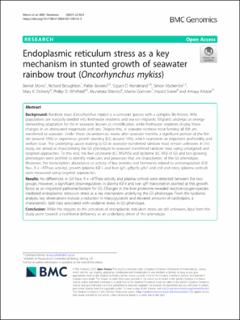| dc.description.abstract | Background Rainbow trout (Oncorhynchus mykiss) is a salmonid species with a complex life-history. Wild populations are naturally divided into freshwater residents and sea-run migrants. Migrants undergo an energy-demanding adaptation for life in seawater, known as smoltification, while freshwater residents display these changes in an attenuated magnitude and rate. Despite this, in seawater rainbow trout farming all fish are transferred to seawater. Under these circumstances, weeks after seawater transfer, a significant portion of the fish die (around 10%) or experience growth stunting (GS; around 10%), which represents an important profitability and welfare issue. The underlying causes leading to GS in seawater-transferred rainbow trout remain unknown. In this study, we aimed at characterising the GS phenotype in seawater-transferred rainbow trout using untargeted and targeted approaches. To this end, the liver proteome (LC-MS/MS) and lipidome (LC-MS) of GS and fast-growing phenotypes were profiled to identify molecules and processes that are characteristic of the GS phenotype. Moreover, the transcription, abundance or activity of key proteins and hormones related to osmoregulation (Gill Na+, K + –ATPase activity), growth (plasma IGF-I, and liver igf1, igfbp1b, ghr1 and ctsl) and stress (plasma cortisol) were measured using targeted approaches. Results No differences in Gill Na+, K + –ATPase activity and plasma cortisol were detected between the two groups. However, a significant downregulation in plasma IGF-I and liver igf1 transcription pointed at this growth factor as an important pathomechanism for GS. Changes in the liver proteome revealed reactive-oxygen-species-mediated endoplasmic reticulum stress as a key mechanism underlying the GS phenotype. From the lipidomic analysis, key observations include a reduction in triacylglycerols and elevated amounts of cardiolipins, a characteristic lipid class associated with oxidative stress, in GS phenotype. Conclusion While the triggers to the activation of endoplasmic reticulum stress are still unknown, data from this study point towards a nutritional deficiency as an underlying driver of this phenotype. | en_US |

